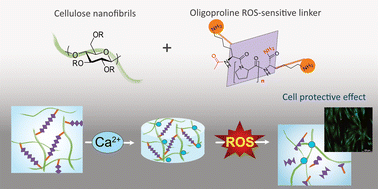Functionalization of cellulose nanofibrils to develop novel ROS-sensitive biomaterials†
Abstract
Wood derived cellulose nanofibrils (CNFs) have emerged as an interesting material for biomedical applications. Functionalization of the nanofibrils with bioactive molecules is a potent tool to tailor CNF materials for specific applications in biomedicine. The present work proposes the functionalization of CNFs with a reactive oxygen species (ROS)-sensitive oligopeptide to develop a novel CNF-based material for the treatment of medical conditions associated with high levels of ROS such as chronic wounds. Oligoproline peptides of two different lengths (5 and 10 proline units) were covalently incorporated onto the CNF surface, several water-based chemical approaches were explored and the reaction conditions to maximize peptide substitution and the degree of fibre crosslinking were optimized. The chemical structure, degree of peptide substitution, degree of fibre crosslinking, surface morphology and ROS-sensitivity of the oligoproline–CNF materials were characterized. Double-crosslinked CNF hydrogels (Ca2+–oligoproline–CNF) were further prepared and the ability of the hydrogels to protect cells from an oxidative environment was investigated in vitro with human dermal fibroblasts, as a first evaluation of the potential of the novel CNF material to be used in chronic wound therapies. Optimization of the reaction conditions resulted in a degree of peptide substitution of 102 ± 10 μmol g−1 CNF irrespective of the oligoproline length and a degree of crosslinking of 55–80% depending on the number of proline units. The results showed that the oligoproline covalently attached to CNFs via carbodiimide chemistry maintained its ability to respond to ROS and that the responsiveness in terms of viscoelastic properties depended on the length of the oligopeptide, with the hydrogel being more responsive when functionalized with 10 proline units compared with 5 proline units. Furthermore, the double crosslinked Ca2+–oligoproline–CNF hydrogels promoted the survival of human dermal fibroblasts exposed to high levels of ROS. This study is the first one to provide an insight into the development of ROS-sensitive materials based on CNFs and opens up possibilities for further investigation on the use of these novel materials in chronic wound care.

- This article is part of the themed collection: Editor’s Choice: Kaushik Chatterjee


 Please wait while we load your content...
Please wait while we load your content...